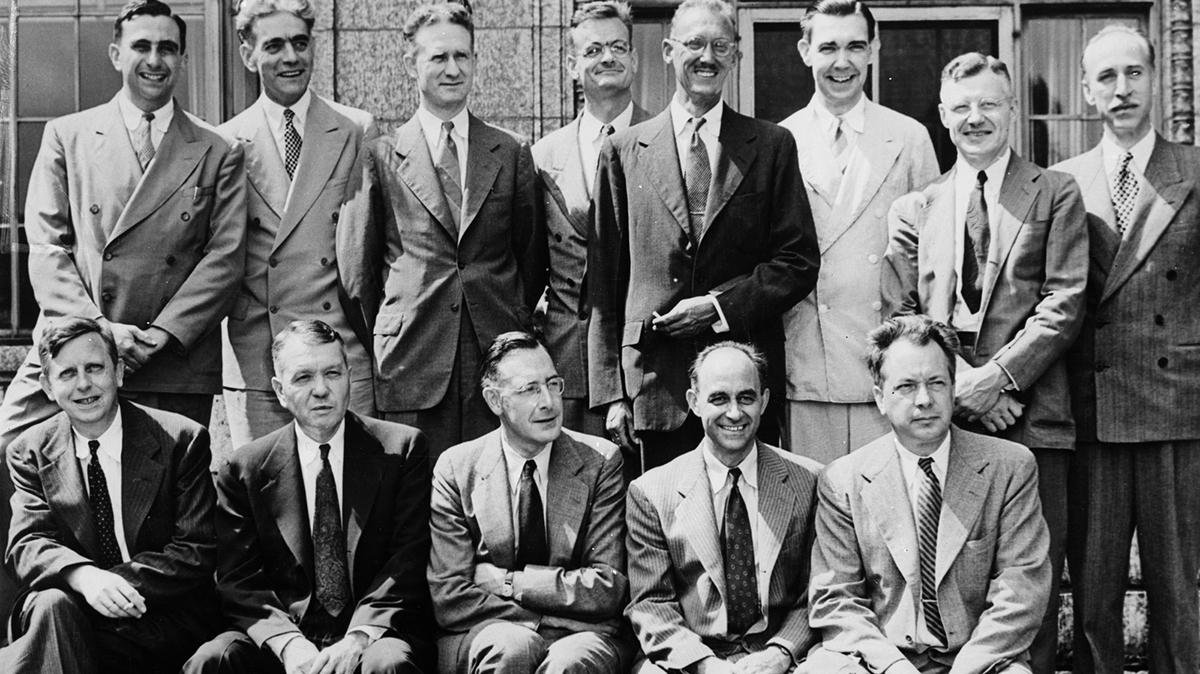Exploring The Legacy Of The Manhattan Project: Key Figures Behind History's Most Influential Scientific Endeavor
Let’s take a trip back in time to one of the most groundbreaking moments in human history—the Manhattan Project. This scientific marvel wasn’t just about creating a bomb; it was about pushing the boundaries of what humanity could achieve, even if it came at a cost. The Manhattan Project reshaped global politics, science, and warfare forever. But who were the masterminds behind this incredible feat? Who were the unsung heroes, the visionaries, and the controversial figures that made it all happen? Let’s dive in and uncover the untold stories of history’s most influential scientific endeavor.
Now, before we jump into the nitty-gritty details, let’s set the stage. The Manhattan Project wasn’t just some random experiment cooked up overnight. It was a massive, top-secret operation during World War II, involving some of the brightest minds on the planet. From physicists to engineers, everyone was working under immense pressure to deliver results that would change the world forever.
But why does the legacy of the Manhattan Project still matter today? Well, it’s not just about the science or the technology—it’s about the ethical dilemmas, the political implications, and the long-term impact on society. Understanding the key figures and their roles gives us a deeper appreciation of how far we’ve come—and how far we still have to go.
Read also:Exploring Elon Musks Partners And Kids A Comprehensive Look
Table of Contents
- Introduction to the Manhattan Project
- Key Figures Behind the Project
- J. Robert Oppenheimer: The Father of the Atomic Bomb
- Albert Einstein: The Visionary Scientist
- Leslie Groves: The Military Mastermind
- Enrico Fermi: The Nuclear Pioneer
- Impact on Modern Science
- Ethical Dilemmas and Controversies
- Political Implications of the Project
- Long-Term Effects on Global Politics
- Conclusion: Reflecting on the Legacy
Introduction to the Manhattan Project
The Manhattan Project wasn’t just a scientific experiment; it was a global game-changer. Launched in 1942, this top-secret initiative aimed to develop the world’s first nuclear weapons during World War II. It was a collaboration between the United States, the United Kingdom, and Canada, and it involved some of the most brilliant minds in physics, chemistry, and engineering. But what made this project so unique wasn’t just its size or scope—it was the sheer audacity of its goals.
Imagine this: a team of scientists and military personnel working in secret locations across the U.S., trying to unlock the secrets of atomic energy. They faced countless challenges, from technical hurdles to ethical dilemmas. Yet, they persevered, driven by a sense of urgency and a belief that their work could end the war. And, in a way, it did—but at what cost?
Key Figures Behind the Project
Behind every great achievement is a team of extraordinary individuals. The Manhattan Project was no exception. From physicists to generals, each person played a crucial role in bringing the project to fruition. Here’s a closer look at some of the key players:
J. Robert Oppenheimer: The Father of the Atomic Bomb
When you think of the Manhattan Project, one name stands out—J. Robert Oppenheimer. This theoretical physicist was the scientific director of the project, and his leadership was instrumental in its success. Oppenheimer wasn’t just a brilliant scientist; he was a visionary who understood the broader implications of his work.
Oppenheimer’s role extended beyond just managing the scientific aspects of the project. He also had to navigate the complex political landscape of the time, working closely with military leaders and government officials. His ability to bridge the gap between science and policy made him an indispensable figure in the project’s success.
Albert Einstein: The Visionary Scientist
While Albert Einstein wasn’t directly involved in the Manhattan Project, his influence was undeniable. It was Einstein’s letter to President Franklin D. Roosevelt in 1939 that sparked the initial interest in atomic research. In the letter, Einstein warned about the potential development of nuclear weapons by Nazi Germany, urging the U.S. to take action.
Read also:Chas Emmerdale Dies The Shocking Truth And What It Means For Fans
Einstein’s theories on the relationship between mass and energy (E=mc²) laid the foundation for the development of nuclear technology. Though he later expressed regret about the destructive use of his discoveries, his contributions to the field of physics remain unparalleled.
Leslie Groves: The Military Mastermind
General Leslie Groves was the man behind the scenes, ensuring that the project stayed on track. As the director of the Manhattan Project, Groves was responsible for overseeing every aspect of the operation, from securing funding to coordinating the efforts of thousands of scientists and engineers.
Groves’ military background made him uniquely qualified for the job. He was known for his meticulous planning and attention to detail, qualities that were essential in managing such a complex project. Without Groves’ leadership, the Manhattan Project might never have succeeded.
Enrico Fermi: The Nuclear Pioneer
Enrico Fermi was another key figure in the Manhattan Project. This Italian physicist was one of the first to achieve a controlled nuclear chain reaction, a breakthrough that paved the way for the development of nuclear weapons. Fermi’s work at the University of Chicago’s Metallurgical Laboratory was critical to the project’s success.
Fermi’s contributions extended beyond the technical aspects of the project. He was also a mentor to many young scientists, helping to shape the next generation of nuclear physicists. His legacy continues to inspire researchers around the world.
Impact on Modern Science
The Manhattan Project didn’t just change the course of history; it also revolutionized the field of science. The advancements made during this period laid the foundation for many of the technologies we use today. From nuclear power plants to medical imaging, the applications of atomic energy are vast and varied.
One of the most significant impacts of the project was the establishment of national laboratories in the U.S. These institutions continue to conduct cutting-edge research in areas such as energy, climate, and health. The collaboration between scientists and engineers during the Manhattan Project also set a precedent for future scientific endeavors, proving that large-scale, interdisciplinary projects can achieve remarkable results.
Ethical Dilemmas and Controversies
Of course, the Manhattan Project wasn’t without its controversies. The use of atomic bombs on Hiroshima and Nagasaki raised serious ethical questions about the morality of such weapons. While some argue that the bombings brought a swift end to the war, others believe that the human cost was too high.
These ethical dilemmas continue to be debated to this day. As we reflect on the legacy of the Manhattan Project, it’s important to consider the broader implications of our scientific advancements. How do we balance the pursuit of knowledge with the potential consequences of our discoveries? It’s a question that scientists, policymakers, and citizens alike must grapple with.
Political Implications of the Project
The political ramifications of the Manhattan Project were far-reaching. The development of nuclear weapons fundamentally altered the balance of power in the post-war world, leading to the Cold War and the arms race between the U.S. and the Soviet Union. The project also highlighted the importance of international cooperation in addressing global challenges.
Today, the lessons of the Manhattan Project continue to influence global politics. The proliferation of nuclear weapons remains a pressing concern, and efforts to prevent the spread of these technologies are ongoing. The project serves as a reminder of the power—and the responsibility—that comes with scientific innovation.
Long-Term Effects on Global Politics
Looking back, it’s clear that the Manhattan Project had a profound impact on global politics. The development of nuclear weapons not only changed the nature of warfare but also shaped the geopolitical landscape for decades to come. The project demonstrated the importance of scientific research in addressing global challenges, but it also highlighted the need for responsible stewardship of new technologies.
As we face new challenges in the 21st century, from climate change to cybersecurity, the lessons of the Manhattan Project remain relevant. How do we ensure that our scientific advancements benefit humanity as a whole, rather than just a select few? It’s a question that requires careful consideration and collaboration from all sectors of society.
Conclusion: Reflecting on the Legacy
So, there you have it—the incredible story of the Manhattan Project and the key figures behind it. From J. Robert Oppenheimer to Albert Einstein, each person played a vital role in shaping the course of history. The project’s legacy is complex, filled with both triumphs and tragedies, but one thing is clear: it changed the world forever.
As we reflect on the lessons of the past, let’s not forget the importance of responsible innovation. The Manhattan Project reminds us that with great power comes great responsibility. Whether you’re a scientist, policymaker, or citizen, you have a role to play in shaping the future of our planet.
Now it’s your turn. What do you think about the legacy of the Manhattan Project? Do you believe that the benefits outweigh the costs? Share your thoughts in the comments below, and don’t forget to check out our other articles for more fascinating insights into history’s most influential moments. Together, let’s keep the conversation going and continue exploring the untold stories of our past!


